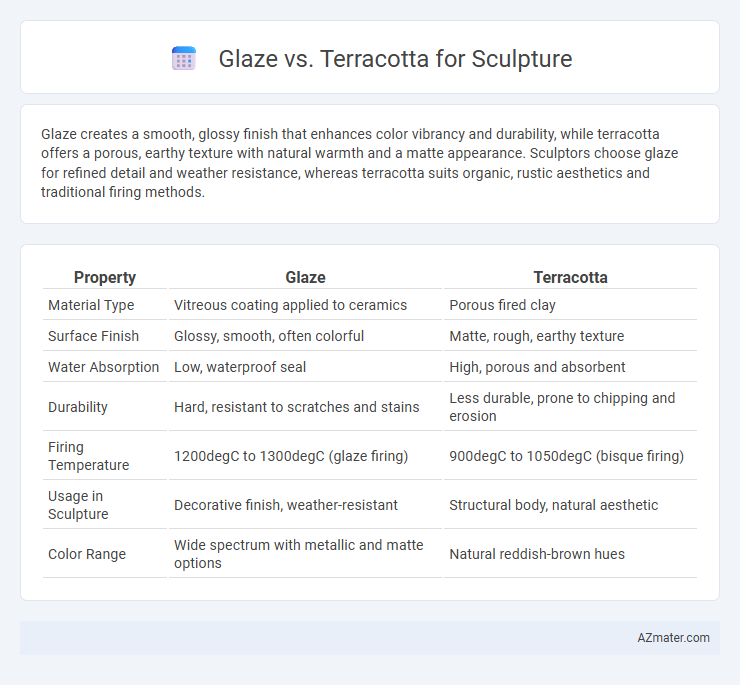Glaze creates a smooth, glossy finish that enhances color vibrancy and durability, while terracotta offers a porous, earthy texture with natural warmth and a matte appearance. Sculptors choose glaze for refined detail and weather resistance, whereas terracotta suits organic, rustic aesthetics and traditional firing methods.
Table of Comparison
| Property | Glaze | Terracotta |
|---|---|---|
| Material Type | Vitreous coating applied to ceramics | Porous fired clay |
| Surface Finish | Glossy, smooth, often colorful | Matte, rough, earthy texture |
| Water Absorption | Low, waterproof seal | High, porous and absorbent |
| Durability | Hard, resistant to scratches and stains | Less durable, prone to chipping and erosion |
| Firing Temperature | 1200degC to 1300degC (glaze firing) | 900degC to 1050degC (bisque firing) |
| Usage in Sculpture | Decorative finish, weather-resistant | Structural body, natural aesthetic |
| Color Range | Wide spectrum with metallic and matte options | Natural reddish-brown hues |
Introduction to Glaze and Terracotta in Sculpture
Glaze in sculpture refers to a glass-like coating applied to ceramic surfaces, enhancing durability and adding vibrant color or texture. Terracotta is a porous, reddish-brown clay material traditionally used for sculpting, known for its natural earthy finish and versatility. Understanding the properties of both glaze and terracotta is essential for artists to achieve desired aesthetic and functional outcomes in ceramic sculptures.
Historical Background of Terracotta and Glazed Sculptures
Terracotta has been used since ancient civilizations, notably by the Indus Valley, Mesopotamians, and the Etruscans, known for its durability and earthy aesthetic in sculpture. Glazed sculptures gained prominence in ancient China during the Tang Dynasty, where ceramic glazes added color, texture, and protective qualities to art pieces. Both materials reflect historical advancements in kiln technology and cultural expression, with terracotta emphasizing natural form and glaze showcasing vibrant surface finishes.
Material Composition: Terracotta vs Glazed Surfaces
Terracotta is made from natural clay, fired at lower temperatures, resulting in a porous, earthy texture that allows for detailed modeling and a warm, matte finish. Glazed surfaces involve an additional glassy coating fused onto the ceramic body through high-temperature firing, creating a glossy, waterproof layer that enhances durability and color vibrancy. The key material difference lies in terracotta's porous, unsealed surface versus the impermeable, often colorful finish of glazed sculptures.
Aesthetic Qualities of Glaze and Terracotta
Glaze on sculpture offers a vibrant, glass-like finish that enhances color depth and surface texture, creating a glossy or matte aesthetic that can evoke luminosity and richness. Terracotta features a warm, earthy tone with a porous, matte surface that emphasizes natural textures and organic forms, imparting a timeless, rustic appeal. Both materials highlight different artistic expressions: glaze accentuates detail through color and sheen, while terracotta emphasizes form and tactile qualities.
Durability and Longevity Comparison
Glaze on sculptures provides a durable, glass-like coating that enhances resistance to weathering, moisture, and UV damage, significantly extending the artwork's longevity. Terracotta, while naturally porous and susceptible to erosion and cracking over time, can achieve improved durability when properly fired and sealed but typically remains more vulnerable to environmental factors than glazed surfaces. Choosing glazed finishes ensures greater preservation, especially for outdoor sculptures exposed to harsh elements.
Application Techniques: Glazing versus Traditional Terracotta
Glazing offers a smooth, glossy finish achieved through the application of liquid glass that fuses to the surface during high-temperature firing, creating a waterproof and durable coating ideal for detailed color work and surface effects. Traditional terracotta sculpture techniques involve shaping and firing natural clay, producing a porous, matte surface that allows for textural variation and often requires sealing to prevent moisture absorption. The choice between glazing and terracotta hinges on the desired aesthetic and functional qualities, with glazing enhancing vibrancy and protection, while terracotta emphasizes natural, earthy tones and a tactile, organic feel.
Suitability for Different Sculpture Styles
Glaze enhances terracotta sculptures by providing a glossy or matte finish that accentuates fine details and adds color depth, making it ideal for delicate, intricate styles such as figurative or decorative art. Terracotta's porous, earthy texture suits robust, rustic sculptures and larger forms, lending a natural, organic appearance favored in traditional and folk art. The choice between glazed and unglazed terracotta depends on the desired aesthetic and durability, with glaze offering moisture resistance and terracotta highlighting texture and raw material qualities.
Cost and Accessibility Factors
Glaze offers a wide range of colors and finishes at a generally lower cost than terracotta, making it accessible for artists on a budget. Terracotta, while often more expensive due to its natural clay composition and longer firing process, provides a rustic and earthy aesthetic valued in traditional sculpture. Accessibility to terracotta may be limited in regions without specialized kilns, whereas glazed ceramics can often be produced with more readily available materials and equipment.
Environmental Impact of Each Material
Glaze coatings on sculptures often contain heavy metals and chemicals that can leach into the environment during production and disposal, posing ecological risks. Terracotta, being a natural clay material, has a lower environmental footprint, especially when fired in energy-efficient kilns, as it is fully biodegradable and free from toxic additives. Choosing terracotta over glazed finishes reduces pollution and promotes sustainability in sculptural art practices.
Choosing the Right Material for Your Sculpture
Glaze offers a glossy, durable finish that enhances color vibrancy and protects terracotta sculptures from moisture and wear, making it ideal for outdoor or high-traffic displays. Terracotta provides a warm, earthy texture with natural porosity, allowing for a more organic aesthetic but requiring sealing to prevent damage. Selecting between glaze and terracotta depends on the desired visual effect, environment exposure, and maintenance preferences for your sculpture.

Infographic: Glaze vs Terracotta for Sculpture
 azmater.com
azmater.com